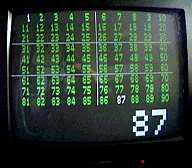|
|
Bingo!!! (on your tv)
|
 |
This design is based on the video DVM and cronograph design. It supports color, so numbers not yet drawn (all but 1 and 87 in the picture on the left) are displayed in green and the others in white. White lines are intentional, according to the Italian rules the drawer itself takes place in game choosing one of the six regions.
<<Monitor picture courtesy of Hagen Patzke |
The schematic is very simple, and it is a stripped-down version of the video-cronograph. This is why both green and red lines a brought to the SCART, even if only the green is used by the software. The sync signal and the white graphics goes to the video pin. The fast blanking signal switches from black and white video input to the RGB signals: this fast input is capable of pixel-by-pixel switching! When it is active, the green numbers are drawn.
The RESET needs special care.
Improper RESET causes eeprom corruption, that in turn distorts the font shapes.
Simple RC based resets are out of question, I have chosen an MC34064
(Motorola) instead.
Hagen Patzke tried succesfully the single-transistor reset schematic
it found from the Atmel's Application Notes
for AVR microcontrollers.
|
Here is my prototype: follow it if you are going to design a PCB, only one wire jumper is needed. The red key is for drawing numbers, the black one resets the game: powering it off is not enough because data is stored in EEPROM so numbers are never lost (quite a professional feature, isn't it?). Click here for a full size picture of the component and solder sides. |
 |
The programming tech is brought to the extremes (read: strict bitbanging), since displaying 90 small numbers on a screen (using a 512 lines assembler program) is a tough task even for a fast microcontroller as the Atmel's AVR AT90S1200. The (admittedly dirty) code and the schematic are derived from the video-cronograph project, cutting off the serial port output and the photocells input, so don't be surprised to find some "strange" variable names.



